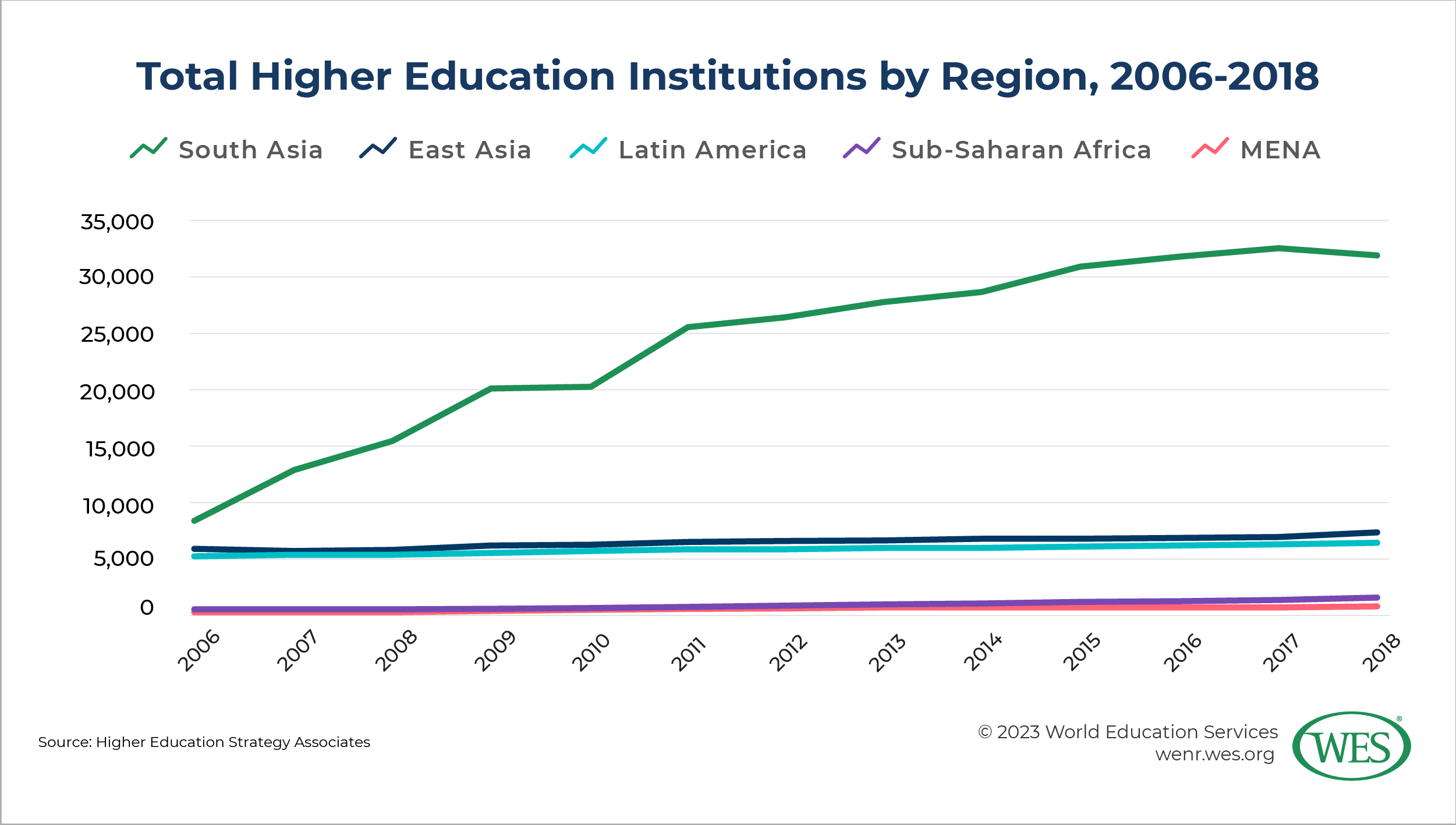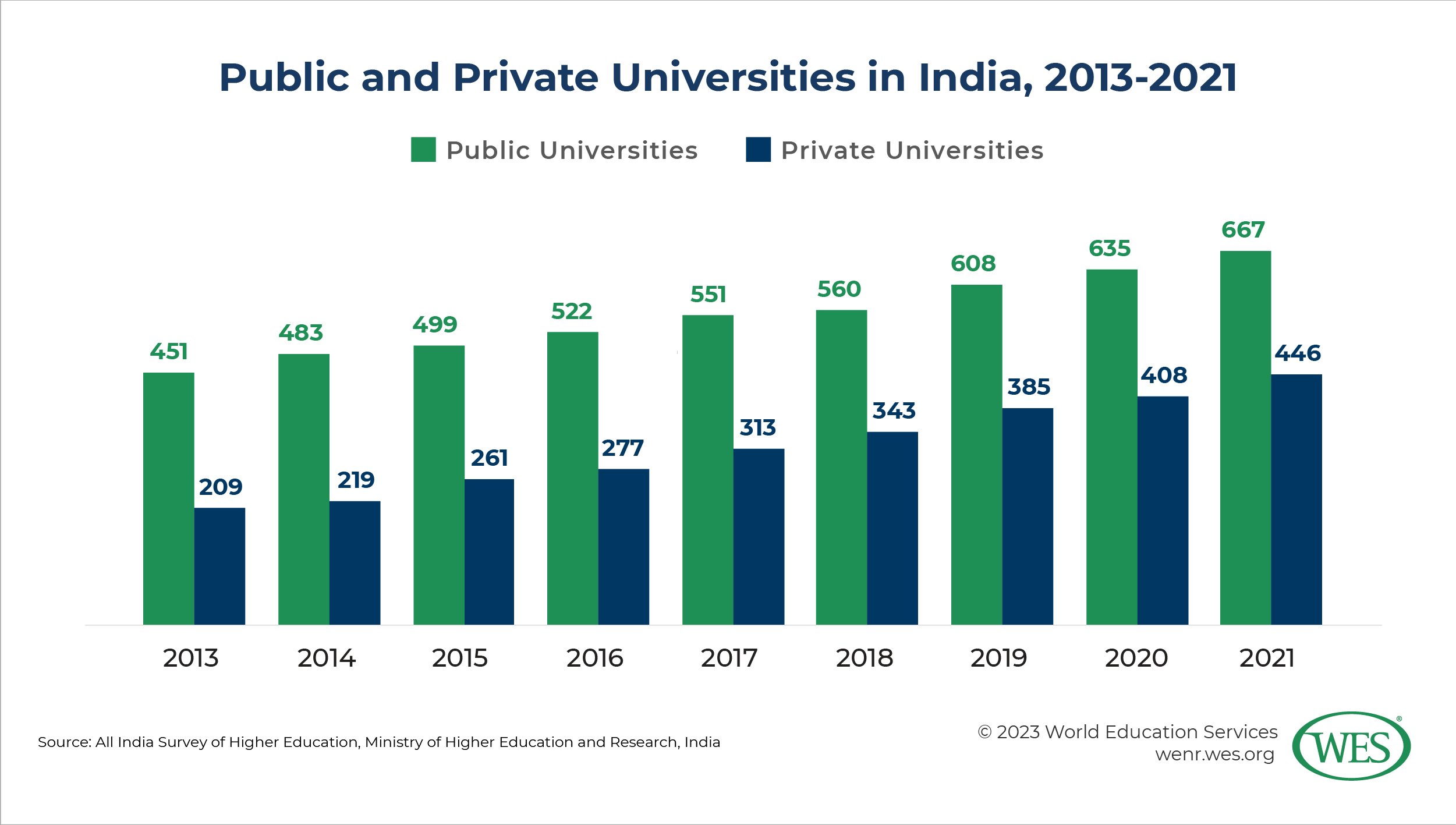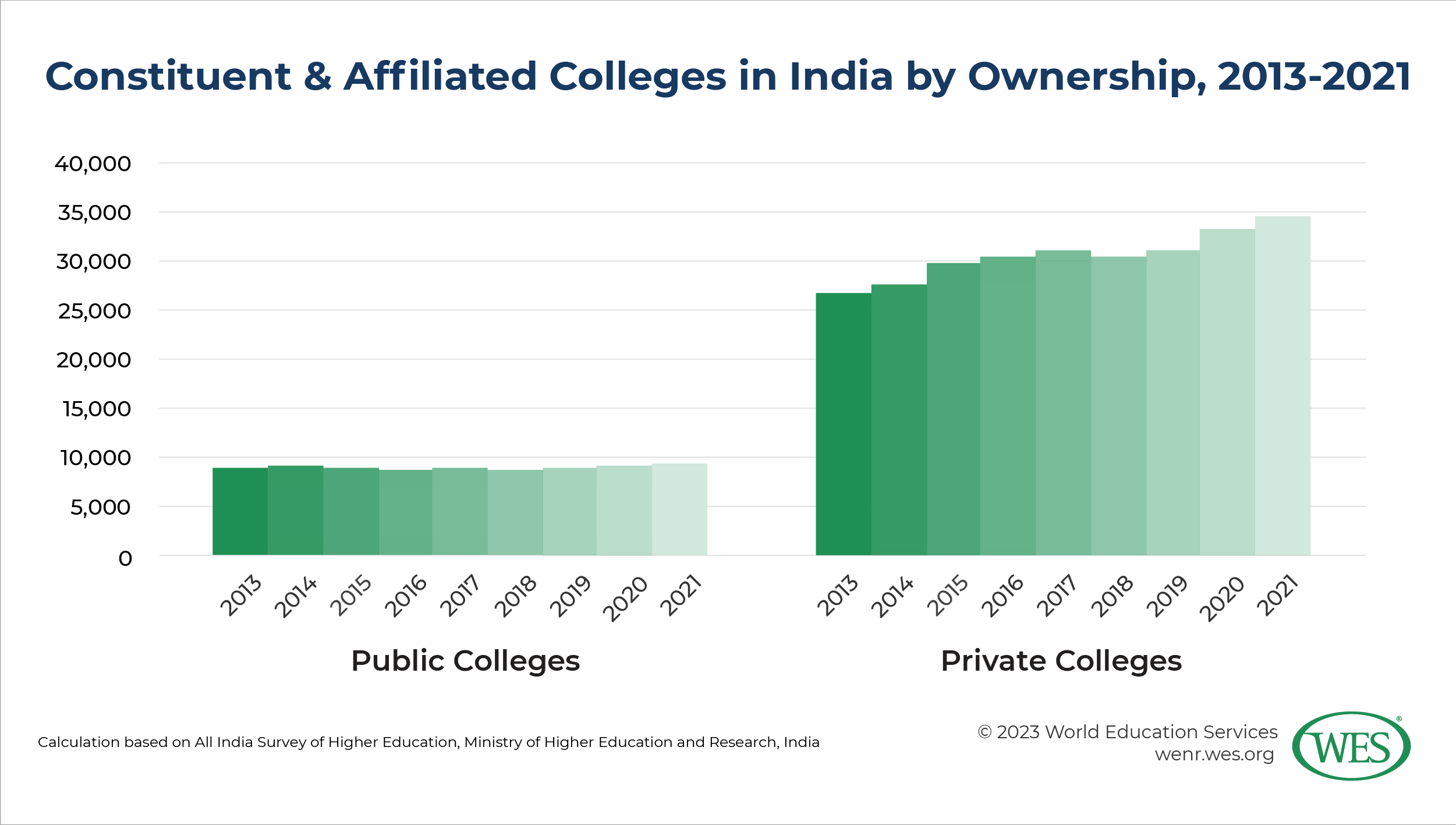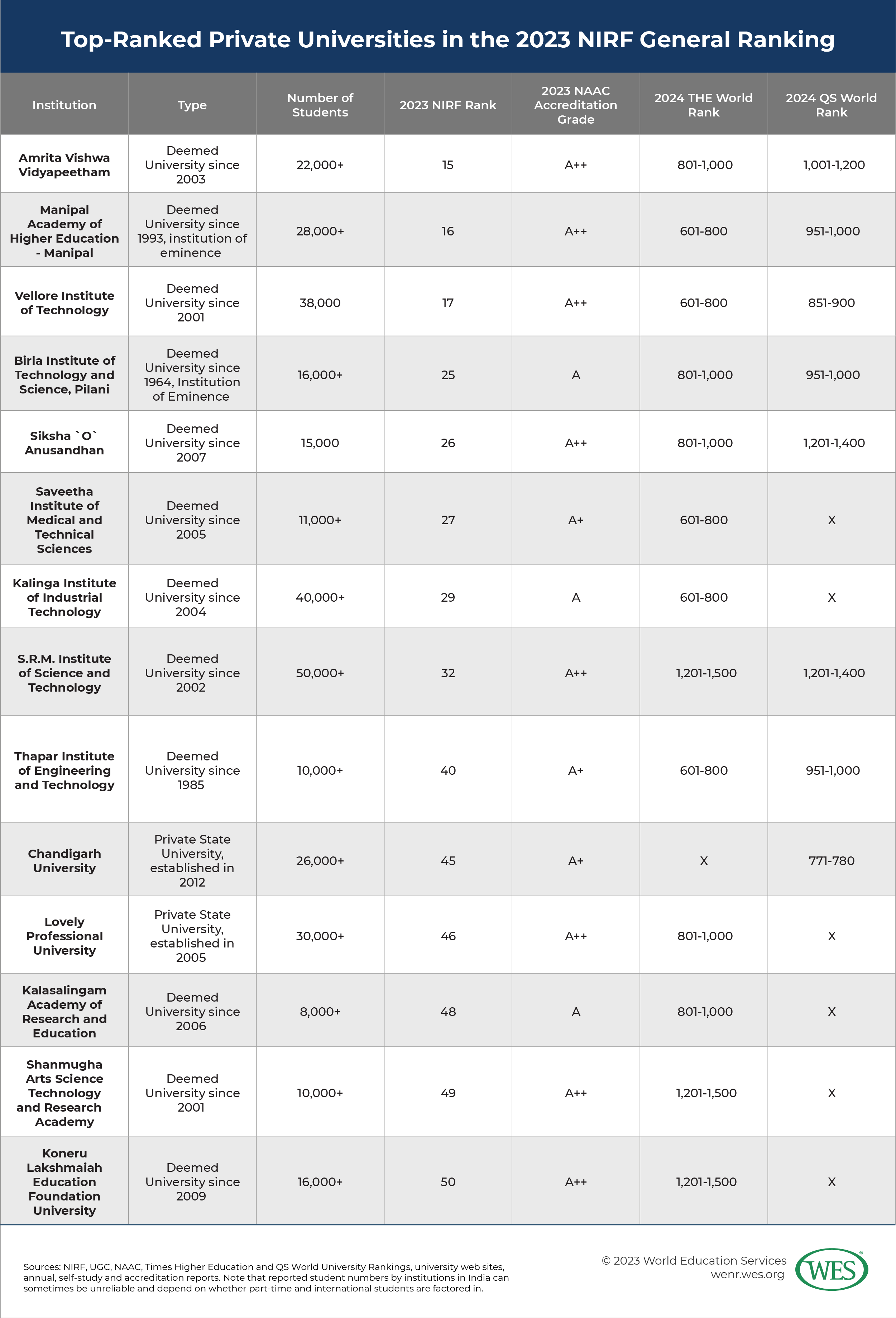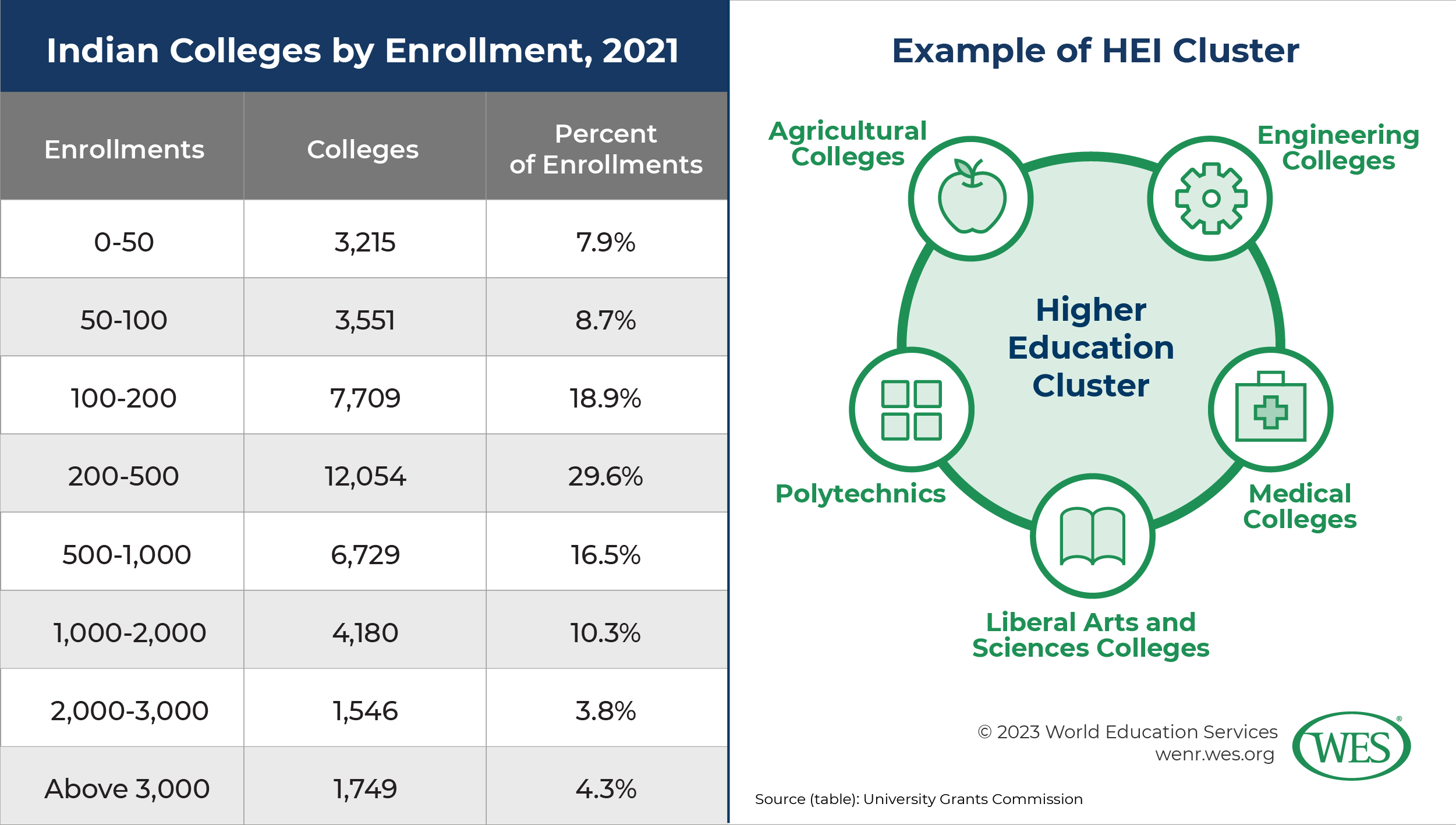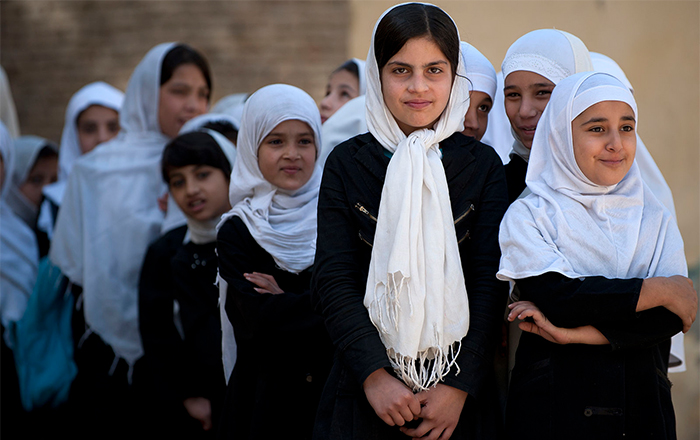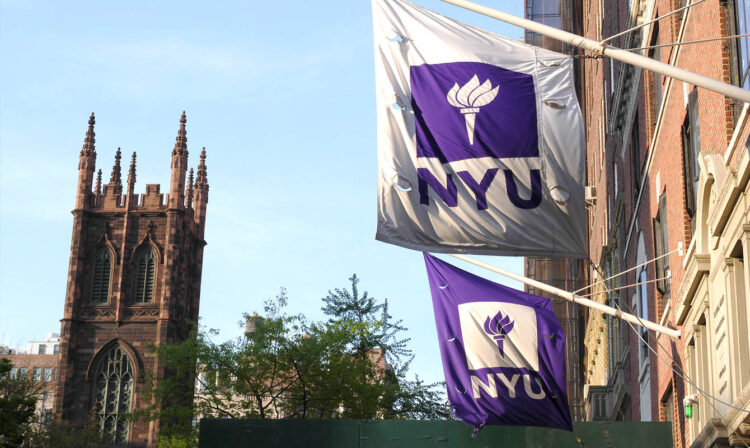Part 1: India
The privatization of higher education is an enduring global trend. Already a decade ago, more than one in three higher education students worldwide was enrolled at a private institution, according to the Program for Research on Private Higher Education. The importance of private higher education (PHE) varies by country and region. Its recent growth largely took place in developing nations and post-Communist countries, where private education was mostly marginal or banned until the 1990s. In some world regions, such as Western Europe, the relevance of PHE is still limited, if growing. In the United States, which has a large and mature private education sector, the share of enrollments at private higher education institutions (HEIs) has actually declined in recent years. In regions like Latin America and South Asia, on the other hand, privatization is surging. Recent UNESCO research shows that South Asia underwent he most rapid growth in education privatization worldwide over recent decades. In a 2022 report, the organization points out that this world region now has the largest presence of non-state actors in education.
UNESCO’s analysis spans the larger South Asia region, including Afghanistan and Iran, and encompasses all levels of education from pre-primary to tertiary. This publication focuses more narrowly on higher education in the most populous countries of the Indian subcontinent: Bangladesh, India, Nepal, Pakistan, and Sri Lanka. Privatization in the higher education sectors of these countries, which are home to almost a quarter of the world’s population combined, is uneven: The share of higher education enrollments at private institutions ranged from 57 percent in India to only 12 percent in Sri Lanka in 2020. The COVID-19 pandemic, along with declines in workforce participation and disposable household incomes, has led to a slight decrease in private sector enrollments in some South Asian countries, at least temporarily.
In general, however, PHE on the Indian subcontinent has risen markedly over the past two decades. Governments in the region face the enormous challenge of providing access to education for rapidly growing youth populations. Despite the creation of ever more HEIs, tertiary enrollment ratios in the region remain low by global comparison. Amid vast demand-supply gaps, the promotion of PHE has become a common policy response by fiscally overburdened states. At the same time, the rising number of middle- income households in South Asia, projected to almost double by midcentury in India alone, means that more people there will be able to afford private education in the future.
This article provides an overview of the genesis and scale of PHE in the region and discusses the impact of the ongoing marketization trend—its benefits, disadvantages, and policy implications. This sector analysis should make clear that PHE will likely remain a fixture of most South Asian education systems and could even grow in scope and significance in coming years. The first part of the article, presented here, focuses on India, by far the largest country in South Asia. A forthcoming second part will explore the trends in the other countries and conclude with a comparative analysis.
India: Background
India currently has the largest higher education system in the world after China. The country’s tertiary sector underwent massive growth over recent decades. In 1954, India had only 2.6 million students enrolled at 31 universities and some 900 colleges. By 1992, these figures had risen to 4.7 million students, 187 universities, and 7,958 colleges—before jumping to 39.4 million students enrolled at 1,043 universities and about 46,000 colleges in 2022. To put this growth into perspective, more than two new HEIs opened in India each day on average over the past decade.1 India’s public Indira Gandhi National Open University (IGNOU) is now considered the world’s largest university, with about 3.3 million students.
Despite this expansion, however, India’s tertiary gross enrollment ratio (GER) has not surpassed 27.1 percent (compared with a ratio of 59.6 in China and an average of 76 percent in OECD countries). While this GER is generally on par with that of other lower middle income countries,2 India struggles to educate a mushrooming youth population that currently comprises about 560 million people under the age of 25—a population group that makes up approximately one-fifth of the world’s youth population and is significantly larger than the entire population of the European Union.
Although India is still a largely agricultural society, with 44 percent of the workforce employed in the primary sector, the country is developing and transforming rapidly: The accelerating growth of middle classes in urban centers creates brings with it pressing demands for education that remain unmet by an overburdened and underfunded system. Admission into top-tier universities and programs in popular disciplines is all but a Darwinian struggle for Indian students. Admission rates at the top-rated Indian Institutes of Technology (IITs), for instance, can be as low as 0.5 percent. Medical education in India is so costly and difficult to access that large numbers of students have left to study in less academically expensive countries like China, Ukraine, Russia, or the Philippines.
Scale of Privatization
It is against this backdrop that private education grew dramatically in India in recent years. PHE has been a major contributor to enrollment increases in the country over the past two decades. The advent of such a mass-scale private sector is a new phenomenon in India. Following independence in 1947, India was mostly ruled by socialist governments with limited appetite for private education. The country’s entire economy was largely state managed. Not until the 1980s did free market reforms there take hold, a process that strongly accelerated in the 1990s.
PHE rose to prominence during this liberalization phase, in the mid-1990s to early 2000s, and was increasingly welcomed as an alternative way to enlarge capacity amid surging demand and fiscal exhaustion. PHE was also regarded as a way to enhance education quality by sparking competition for public universities.
Most of India’s private universities were established by an act of parliament of India’s states rather than the central government. India is a federal system in which the central and state governments share responsibility for managing education. Both the states and the Union Government in New Delhi can create new universities. Delhi in 1995 attempted to regulate private universities more uniformly at the federal level and stipulate rules for their establishment, but couldn’t overcome opposition from the states, which viewed this as an infringement on their constitutional rights. While not all of India’s states immediately embraced private universities, many of them have rushed to promote PHE since the mid-1990s. The central government, likewise, has since that time progressively approved the establishment of more private HEIs.
The first private university created under state law was the Sikkim Manipal University of Health, Medical and Technological Sciences, established in 1995 in the small state of Sikkim. Since then, the number of private universities of different types has spiked to a total of 489 as of 2022. Growth has been pronounced in recent years: Between 2016 and 2021, private universities in India increased by more than 60 percent. Private universities now exist in almost all Indian states, with the largest numbers located in Rajasthan, Gujarat, and Madhya Pradesh.
Formally, no private universities have been created in the eight union territories3 that are under central government control. In practice, though, the central government has granted a status called “deemed-to-be-university” to various private institutions, both in union territories and in several states. This special status, granted solely at the discretion of the central government, confers degree-granting authority to non-university HEIs. This means that deemed universities in most aspects have equal standing with and are commonly categorized as universities (including in this article). Most private deemed universities were established from the late 1990s on; many specialize in particular academic fields, but several are multidisciplinary. There are currently 124 deemed universities, 80 of which are self-financed.
Viewed in terms of universities alone, India’s 489 private institutions don’t seem especially numerous; fewer than half of India’s universities are privately owned, and they enrolled only around 26 percent of the country’s tertiary students in 2022. (The U.S., by comparison, has almost 4,000 private HEIs.) However, it’s important to understand that India’s higher education system includes relatively few universities, but a much higher number of smaller teaching institutions, called affiliated colleges, that operate under the umbrella of public universities. These colleges, which teach university curricula on behalf of the affiliating university, used to be predominantly public or government-subsidized “private aided” institutions. But most of them—65 percent—are now self-financed “private unaided” institutions. There were 42,510 affiliated colleges in India in 2022.
This college system, which has grown exponentially over the past two decades, has allowed Indian state universities to scale up their enrollment capacities and helped to create new revenue streams, since universities charge colleges an “affiliation fee.” In 2022, 44.4 percent of India’s total college enrollments were in private unaided institutions, and another 13.6 percent were in private aided institutions. In essence, a large share of graduates of public universities actually studied at private institutions.
In addition, private providers are dominant among so-called “stand-alone institutions.” These comprise over 11,000 specialized HEIs such as polytechnics, teacher training institutes, nursing schools, and business colleges. Around 76 percent of these institutions are privately owned, and they enroll the majority of students in this sector.
In the context of India’s overall higher education landscape, PHE has grown from a peripheral phenomenon to a core feature of the system within decades. In 2022, fully 55.5 percent of higher education students were enrolled in private HEIs in India, according to UNESCO statistics. That percentage represents a small drop of 1.5 points in the wake of the COVID-19 pandemic. But it’s the largest such share in South Asia and represents a high number by global standards. In the U.S., by comparison, fewer than 30 percent of tertiary students attended private HEIs in 2021, per the same UNESCO statistics.4
Alongside this privatization boom in formal education, a vibrant and fast-growing private edtech sector, including a thriving tutoring industry, has sprung up in India. The country is now considered to have the second largest edtech market worldwide after the United States. While estimates on the size of this sector vary greatly, its recent growth rates have been robust. According to Forbes, India’s edtech industry will grow from a US$700-to-$800 million market in 2021 to a $30 billion industry by the beginning of the next decade, driven by strong demand and the popularization of new digital forms of learning.
Scope and Quality of PHE
Private HEIs in India’s vast and sprawling education system are a diverse group. As noted, most are smaller colleges affiliated with universities and stand-alone institutions. A majority of these institutions are located in rural areas. Many stand-alone institutions are vocationally oriented schools running post-secondary certificate and diploma programs, but this group also includes hundreds of business institutes offering postgraduate diploma programs in business management.
Most of these institutions earn their revenues from tuition fees and tend to offer fewer but profitable programs popular with students. Part of the appeal of private institutions is that they provide short-cycle certificate and diploma programs that are in short supply in the public sector but viewed as beneficial for employment prospects. The expansion of technical and vocational education is currently a key priority of the Indian government and well-funded. Public universities like IGNOU and other universities offer a variety of career-focused diploma programs as well, but private colleges remain dominant in technical and vocational education as of today. Government statistics from 2021 show that self-financed private providers enrolled over 70 percent of students in undergraduate technical programs, and 59 percent in postgraduate programs.
At the opposite end of the spectrum are a small number of multidisciplinary private research universities that offer a broad variety of academic programs, from the undergraduate to the doctoral level.
In terms of enrollments, most private universities are dwarfed by massive public universities like Savitribai Phule Pune University and the University of Mumbai, which each have well over half a million students when their affiliated colleges are factored in. Enrollment levels at private universities, in comparison, mostly range from a few thousand, sometimes less, to up to 40,000 or 50,000 students in some cases. The privately owned Amity University boasts that it enrolls 175,000 students and may be the country’s largest private university, dispersed over various campuses in different states.
The University Grants Commission (UGC), India’s main regulatory agency in tertiary education, has placed restrictions on private universities that inhibit the potential growth of individual private institutions. Unlike public universities, they are not allowed to grant affiliation to other institutions, so they cannot easily scale up by partnering with a group of colleges.
Universities constituted under state law, meanwhile, are not allowed to set up campuses outside the state where they were established, unless they obtain UGC approval. Institutions like Amity University have overcome such limitations by obtaining recognition in several different states, allowing it to operate campuses across India. Sikkim Manipal University, on the other hand, was forced by the UGC in 2023 to suspend its out-of-state distance education programs after it was found to have illegally operated distance learning centers in various states. Before then, it was one of India’s largest universities, with more than 300,000 students.
As of 2023, the UGC’s Distance Education Bureau has authorized 14 deemed universities and 35 private state universities to run various programs in distance mode, as long as these programs are only offered within the confines of the states in which the institutions are located. Given the nature of distance education, these territorial restrictions can be difficult to enforce and are often flouted, but out-of-state students must generally travel to examination centers in the respective states to sit for their exams.
By law, private universities in India must be non-profit institutions incorporated as charitable trusts. De facto, however, PHE in India is often a for-profit venture. Enforcement of financial regulations involves both state and central governments, depending on the institution, and is frequently litigated in court. Oversight can therefore be weak, and the budgets of some private universities are said to be opaque.
Whereas “aided” private HEIs are largely subsidized by the government, unaided institutions are self-financed, mainly by tuition fees. The revenues of these institutions are supposed to be reinvested into education. However, private HEIs make off-the-books profits in various ways, including by charging higher fees than permitted or by enrolling more students than allowed. Some institutions may sell scarce college seats on the black market for capitation fees or “donations.” A different, legal, way to generate profits is the outsourcing of teaching and management functions to third-party service companies that aren’t bound by the non-profit requirements governing academic institutions.
For consumers, education at private HEIs in India is considerably more expensive than at public institutions. Tuition fees for standard programs in arts and sciences may be twice as high, depending on the institution, but they can be exponentially higher for professional programs in popular disciplines. Top private institutions like the Birla Institute of Technology and Science, Pilani charge tuition fees of approximately US$7,000 per academic year—in a country where the average annual per capita income is around $2,080.
Government spending on tertiary education, including both federal and state expenditures, has increased in recent years and oscillated between 1.2 and 1.5 percent of GDP since 2010. This number compares favorably with spending ratios in other lower middle income countries, but the rate of recent spending increases is below the growth rate of the overall higher education system, so that the expansion of India’s system over the past few decades has been largely funded by private households. Education in India is expensive and its costs for consumers are rising fast.
As for the quality of PHE in India, the record is mixed. Some observers paint a bleak picture of a mushrooming commercialized sector filled with low-quality providers. While that is a simplification of current realities, India has indeed seen major quality problems in PHE. In one example from the early phases of privatization, the state of Chhattisgarh in 2002 enacted “umbrella legislation” that ushered in an unprecedented flood of 112 private universities within just one year (India had a total of only 236 universities, public and private, in 2000). Three years later, India’s Supreme Court invalidated the law and ordered the closure of these institutions, which were said to lack basic infrastructure and were dubbed “degree shops” by the Indian press.
In 2009, the union government enacted a temporary moratorium on the establishment of new deemed universities. The government committee that recommended this step noted in its final report that many institutions circumvented admissions standards, overenrolled students beyond capacity, and created unapproved programs and distance education operations of questionable quality while failing to conduct meaningful academic research. As a result of the audit, 44 deemed universities were de-recognized by the government in 2010.
Reports of quality problems in India’s lucrative medical education market have also become commonplace in recent years. At one end of the equation are quality private medical colleges with a long tradition, such as Christian Medical College Vellore and St. John’s Medical College. On the other end are newer professional colleges that abruptly sprang up as business ventures, started by politicians and entrepreneurs without experience in education or medicine.5 Several of these colleges are said to disregard accreditation standards and to suffer from faculty shortages and inadequate laboratory facilities. The Times of India lamented in 2016 that some of India’s doctors are trained at institutions “with little or no facilities, no patients and fake faculty.”
The high demand for education In India, coupled with regulatory diffusion, explosive growth, and transformation in a massive system with tens of millions of students, creates opportunities for fraud and corruption in both private and public sectors. In one recent incident, Manav Bharti University, a private state university in Himachal Pradesh, was investigated in 2020 for selling as many as 50,000 bogus degrees. There’s also the issue of non-accredited “fake universities”—sketchy providers or simply diploma mills selling degrees. The UGC blacklists these “universities” on its website each academic year but has so far failed to effectively curb such sham providers, which operate at the crossroads of corruption and regulatory loopholes.
Such problems aside, it would be a mistake to portray PHE in India as low quality across the board. In 2013, former Indian Minister of State for Human Resource Development Shashi Tharoor described public elite institutions like the IITs as “islands of excellence in a sea of mediocrity,” but India’s higher education landscape has evolved and diversified substantially since then. Despite PHE still being relatively new in India, several private institutions are rising quickly among the ranks of India’s best universities. It should also be noted that vast disparities in quality also exist among public HEIs.
India’s government has sought to strengthen the quality assurance of private HEIs over the years while simultaneously making greater efforts to encourage quality education and reward good performance with financial incentives and greater autonomy for institutions. In general, private HEIs must abide by central UGC standards and regulations or, in the case of technical colleges, those of the All India Council for Technical Education (AICTE)—even if they don’t receive government funding. New private HEIs are usually required to obtain accreditation from one of India’s accreditation bodies within years of being established, although institutions may be slow to abide by these accreditation requirements.
Aside from strengthened oversight, some private HEIs invest in quality education because it’s in their own commercial interest. Some observers have found that teacher-to-student ratios, for example, are better in private than in public universities on average. Current figures published by the Times Higher Education for 124 Indian universities show that 10 out of the 15 HEIs with the best teacher-to-student ratios on this list are smaller private institutions.6 But further research would be needed to substantiate this observation for India’s heterogeneous and disparate higher education system writ large.
Overall, private HEIs have found greater social acceptance in India. As Eldho Mathews, an advisor to India’s National Institute of Educational Planning and Administration, noted in a recent article, there’s an increasing “stratification of private universities into ‘traditional private’ and ‘elite private’ universities,” the latter including newer and smaller private institutions like Ashoka University (founded in 2014) and O.P. Jindal Global University (founded in 2009). Whereas education at traditional private universities is more labor market focused, elite private universities have a greater emphasis on research and academic credibility. The Times Higher Education (THE) describes this stratification as follows: “Older private universities … limited themselves to offering degrees in engineering or business management; humanities and social science departments, if they existed, were minuscule. Few, if any, carried out any research. But the elite privates are comprehensive institutions that include large social sciences departments. They are research-oriented, and their faculty roster is comparable to that of major public institutions.”
India’s higher education landscape currently includes a sizable number of quality private HEIs. While some have argued that it’s unfair to directly compare private institutions with well-funded central flagship universities and the prestigious IITs, some private universities compare favorably: 14 of them were among the top 50 institutions in the most recent National Institutional Ranking Framework (NIRF), an important annual ranking by the central Ministry of Education that rates institutions according to the quality of their teaching, resources, research, graduation outcomes, outreach and inclusion efforts, as well as the perception of them in India. These institutions, most of which are deemed universities, are listed in the table below, along with their rating by India’s National Assessment and Accreditation Council (NAAC) and placement in different international rankings.
The central government has also declared four top private universities “institutions of eminence” under a special recognition scheme which grants them greater autonomy. The eventual goal is to develop ten private universities into “world class institutions” alongside ten of the best public institutions. Even though the well-nurtured public IITs continue to dominate international rankings like the Times World University Ranking and the QS World University Ranking, several private universities are included in these rankings as well.
Future Outlook
In its latest 2020 National Education Policy (NEP), the Indian government set the goal of reaching a tertiary GER of 50 percent by 2035. This objective and other improvements in the school system are envisioned to be achieved by boosting total education spending (in all education sectors) from 4.6 percent of GDP (2021) to 6 percent of GDP. Central education budgets have increased substantially in recent years, although the picture looks less favorable when factoring in inflation and spending levels in the states. If the past decades are any guide, it’s an open question if India’s ambitious growth aspirations—which would mean adding at minimum another 30 million students to an already overstretched higher education system—can be achieved without even greater participation of the private sector.
Given the neoliberal “lean government” agenda of the current administration, and the tremendous resources required to raise the tertiary GER by 23 precent, its’ likely that PHE will continue to be a key player in India. The economic policies of Prime Minister Narendra Modi and his Hindu nationalist Bharatiya Janata Party (BJP), in power since 2014, have focused on liberalization and privatization of parts of the economy, if with modest success. For instance, Modi sought to deregulate and open the agricultural sector for private competition, but had to reverse course amid mass protests by farmers. The government also pursued divestment from state-owned enterprises, although this objective has been slow to achieve. The national airline Air India is one of the few big state enterprises that have been privatized thus far.
In education, the administration oversaw a drastic expansion of PHE and a shift in education financing from public to private sources. This was facilitated by policies like the introduction in 2018 of a “graded autonomy scheme“ that allowed top-performing public HEIs to charge higher tuition fees and operate new private-sector-style self-financed programs. The government has also attempted to reduce public education expenditures by partially shifting funding for public HEIs from non-repayable UGC grants to repayable (non-interest) loans provided by the Higher Education Financing Agency (HEFA), an institution set up in 2017 as a joint venture of the federal government and a private bank.
The NEP includes a section on “curbing the commercialization of education”, which represents an effort to rein in the extralegal tuition and capitation fees charged by some private HEIs. Beyond that, there are few indications that the central government seeks to curb the scale of PHE overall. The vision set forth is one of greater centralization and federal control over the entire education system combined with a laissez faire approach towards a greater number of academic institutions.
The goal is to create a “light but tight” single regulator for higher education that would usurp India’s different and overlapping quality assurance bodies. At the same time, more HEIs, both public and private, will be given greater freedom in academic and financial matters under an expanded three-tiered graded autonomy scheme for all universities and colleges based on their NAAC rating. These objectives largely represent a continuation of previous policies. A unified quality assurance body has been envisioned in India for decades and proposed by the Modi administration for years. Graded autonomy schemes already exist, if on a smaller scale.
However, that is not to say the NEP, if implemented consistently, won’t bring drastic changes to PHE and the Indian higher education system in general. One big shift will be consolidation within the system, resulting in fewer but larger multidisciplinary HEIs. The college affiliation system, long criticized for being inefficient, will be phased out in what would be a major transformation affecting the majority of private HEIs. By 2035, all colleges in India would be expected to do one of the following: become multidisciplinary autonomous degree-granting institutions with at least 3,000 students; integrate into a university; or merge into “HEI clusters.” This move will impact most colleges, since more than 80 percent of them currently enroll fewer than 1,000 students. It’s not yet clear how these changes would affect the market share of private HEIs. Some private colleges might close; others might grow and obtain more freedom and opportunities for expansion.
The same changes under the NEP apply to specialized providers, including deemed universities and stand-alone institutions. These HEIs must diversify and transform into multidisciplinary institutions or merge into HEI clusters. It will be a challenge for smaller, mono-specialized colleges that offer employment-oriented technical programs to suddenly introduce liberal arts or science programs. Many institutions won’t have the requisite facilities or resources for such an expansion. The government’s end goal is that India will have only three types of institutions: research-intensive universities, teaching-intensive universities, and autonomous colleges. Deemed universities and other categories of HEIs will be phased out. If these objectives become reality, a major consolidation of India’s higher education system will be the result.
Simultaneously, the Modi administration in 2023 for the first time has allowed foreign universities to establish branch universities in India, as long as these universities are featured among the top 500 in international university rankings. This policy shift, which is hotly contested, could increase competition for India’s universities, public and private alike. On the other hand, the NEP calls for a vast expansion of online and distance learning and a greater integration of vocational training into higher education, all areas that would give private providers ample opportunities for expansion. The promotion of distance education is a major focus of the government and seen as indispensable for expanding access to education.
Crucially, there won’t be regulatory distinctions between public and private universities under the new system. This will most likely mean that private universities will have greater leeway to offer more and different types of programs, including distance education programs and branch campuses in different states. Barring major policy shifts ahead, it is likely that India’s higher education landscape will continue to be an increasingly marketized and competitive system.
That said, every astute India watcher knows that the path from legislation and policy declarations to implementation is long and arduous in India’s fragmented and litigious political system. The NEP was adopted without parliamentary vote or buy-in from India’s states. Aspects of the new policy will likely be disputed in court by state governments, notably in states governed by opposition parties. Delays and setbacks in implementation are probable. The NEP embodies a bold reform agenda that could help India harness the potentially enormous rewards of its demographic youth dividend. But to what extent the current reforms will take hold, and when, remains to be seen.
1. According to annual statistics published by India’s University Grants Commission, the number of colleges alone rose from 35,525 in the 2011-2012 academic year to 46,007 in the 2021-2022 academic year. That represents more than 1,048 colleges per year, or 2.88 per day, on average.
2. The average GER for lower middle-income countries, as defined by the World Bank, was 27 percent in 2022, according to World Bank data.
3. The Republic of India is a federation of 28 states and eight union territories; the latter are directly governed by the federal government. The union territories are Andaman and Nicobar Islands; Chandigarh; Dadra and Nagar Haveli and Daman and Diu; Delhi; Jammu and Kashmir; Ladakh; Lakshadweep; and Puducherry.
4. Examples of countries with even larger private higher education sectors than India’s include Japan and South Korea, where 70 to 80 percent of students have been enrolled at private institutions for years.
5. Supe, Avinash and Sahoo, Soumendra: Malpractice in Medical Education. In: Nundy, Samiran; Desiraju, Keshav; Nagral, Sanjay (eds.): Healers or Predators? Healthcare Corruption in India, Oxford University Press, 2018, Kindle edition, locations 2345-2487:2386.
6. The average ratio among the 124 institutions is 16 instructors per student. The top-performing HEI according to this criterium is the small public Tata Institute of Fundamental Research with 3 students per instructor, followed by Amity University (private/6.8 students per instructor), Saveetha Institute of Medical and Technical Sciences (private/7.1), Dr D. Y. Patil Vidyapeeth (private/7.2), Acharya Nagarjuna University (public/7.3), Bharati Vidyapeeth University (private/7.3), Kalasalingam Academy of Research and Education (private/7.5), Banaras Hindu University (public/8), Nitte (private/8.1), Sri Balaji Vidyapeeth (private/8.7), Chettinad Academy of Research and Education (private/8.9), Mizoram University (public/8.9), Manipal Academy of Higher Education (private/9.1), O.P. Jindal Global University (private/9.1)
The views and opinions expressed in this article are those of the author(s) and do not necessarily reflect the official policy or position of World Education Services (WES).

